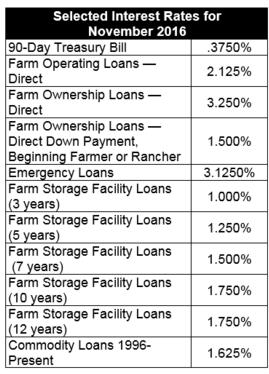|
 Since shares and ownership of a farm can change year-to-year,
producers on the farm must enroll by signing a contract each
program year. Since shares and ownership of a farm can change year-to-year,
producers on the farm must enroll by signing a contract each
program year.
If a farm is not enrolled during the 2017 enrollment period, the
producers on that farm will not be eligible for financial
assistance from the ARC or PLC programs for the 2017 crop should
crop prices or farm revenues fall below the historical price or
revenue benchmarks established by the program. Producers who
made their elections in 2015 must still enroll during the 2017
enrollment period.
The ARC and PLC programs were authorized by the 2014 Farm Bill
and offer a safety net to agricultural producers when there is a
substantial drop in prices or revenues for covered commodities.
Covered commodities include barley, canola, large and small
chickpeas, corn, crambe, flaxseed, grain sorghum, lentils,
mustard seed, oats, peanuts, dry peas, rapeseed, long grain
rice, medium grain rice (which includes short grain and sweet
rice), safflower seed, sesame, soybeans, sunflower seed and
wheat. Upland cotton is no longer a covered commodity. For more
details regarding these programs, go to www.fsa.usda.gov/arc-plc.
For more information, producers are encouraged to visit their
local FSA office. To find a local FSA office, visit
http://offices.usda.gov.

Beginning Farmer Loans
FSA assists beginning farmers to finance agricultural
enterprises. Under these designated farm loan programs, FSA can
provide financing to eligible applicants through either direct
or guaranteed loans. FSA defines a beginning farmer as a person
who:
- Has operated a farm for not more than 10 years
- Will materially and substantially participate in the
operation of the farm
- Agrees to participate in a loan assessment, borrower
training and financial management program sponsored by FSA
- Does not own a farm in excess of 30 percent of the
county’s average size farm. Additional program information,
loan applications, and other materials are available at your
local USDA Service Center. You may also visit
www.fsa.usda.gov.
USDA Issues Safety-Net Payments to Farmers in Response to
2015 Market Downturn
The U.S. Department of Agriculture (USDA) announced that
beginning today, many of the 1.7 million farms that enrolled in
either the Agriculture Risk Coverage (ARC) or Price Loss
Coverage (PLC) programs will receive safety-net payments due to
market downturns during the 2015 crop year.
This fall, USDA will be making more than $7 billion in payments
under the ARC-County and PLC programs to assist participating
producers, which will account for over 10 percent of USDA’s
projected 2016 net farm income. These payments will help provide
reassurance to America’s farm families, who are standing strong
against low commodity prices compounded by unfavorable growing
conditions in many parts of the country.
Unlike the old direct payment program, which issued payments
during both weak and strong market conditions, the 2014 Farm
Bill authorized the ARC-PLC safety net to trigger and provide
financial assistance only when decreases in revenues or crop
prices, respectively, occur. The ARC and PLC programs primarily
allow producers to continue to produce for the market by making
payments on a percentage of historical base production, limiting
the impact on production decisions.
Nationwide, producers enrolled 96 percent of soybean base acres,
91 percent of corn base acres and 66 percent of wheat base acres
in the ARC-County coverage option. Producers enrolled 99 percent
of long grain rice and peanut base acres and 94 percent of
medium grain rice base acres in the PLC option. Overall, 76
percent of participating farm base acres are enrolled in
ARC-County, 23 percent in PLC and one percent in ARC-Individual.
For other program information including frequently asked
questions, visit www.fsa.usda.gov/arc-plc.
Payments are made to producers who enrolled base acres of
barley, corn, grain sorghum, lentils, oats, peanuts, dry peas,
soybeans, wheat and canola. In the upcoming months, payments
will be announced after marketing year average prices are
published by USDA’s National Agricultural Statistics Service for
the remaining covered commodities. These include long and medium
grain rice (except for temperate Japonica rice), which will be
announced in November, remaining oilseeds and chickpeas, which
will be announced in December, and temperate Japonica rice,
which will be announced in early February 2017. Upland cotton is
no longer a covered commodity.

The Budget Control Act of 2011, passed by Congress, requires
USDA to reduce 2015 ARC and PLC payments by 6.8 percent. For
more information, producers are encouraged to visit their local
Farm Service Agency (FSA) office. To find a local FSA office,
visit http://offices.usda.gov.
FSA Urges Farmers and Ranchers to Vote in County Committee
Elections
USDA encourages farmers and ranchers to make their voices heard
by voting in the upcoming Farm Service Agency (FSA) County
Committee elections. Beginning Monday, Nov. 7, 2016, USDA will
begin mailing ballots to eligible farmers and ranchers across
the country. Producers must return ballots to their local FSA
offices by Dec. 5, 2016, to ensure that their vote is counted.
Nearly 7,700 FSA County Committee members serve FSA offices
nationwide. Each committee has three to 11 elected members who
serve three-year terms of office. One-third of county committee
seats are up for election each year. County committee members
apply their knowledge and judgment to help FSA make important
decisions on its commodity support programs, conservation
programs, indemnity and disaster programs, and emergency
programs and eligibility.
Producers must participate or cooperate in an FSA program to be
eligible to vote in the county committee election. Farmers and
ranchers who supervise and conduct the farming operations of an
entire farm, but are not of legal voting age, also may be
eligible to vote.
Farmers and ranchers will begin receiving their ballots the week
of Nov. 7. Ballots include the names of candidates running for
the local committee election. FSA has modified the ballot,
making it easily identifiable and less likely to be overlooked.
Voters in local administrative area holding an election who do
not receive ballots in the coming week can pick one up at their
local FSA office. Ballots returned by mail must be postmarked no
later than Dec. 5, 2016. Newly elected committee members will
take office Jan. 1, 2017.
For more information, visit the FSA website at www.fsa.usda.gov/elections
or contact your local County FSA office.
USDA Expands Working-Lands Conservation Opportunities through
CRP
USDA will offer a new Conservation Reserve Program (CRP)
Grasslands practice specifically tailored for small-scale
livestock grazing operations. Small livestock operations with
100 or fewer head of grazing dairy cows (or the equivalent) can
submit applications to enroll up to 200 acres of grasslands per
farm. USDA’s goal is to enroll up to 200,000 acres.

The current CRP Grassland ranking period will end on Nov. 10,
2016. To date, the USDA’s Farm Service Agency (FSA) has received
nearly 5,000 offers covering over 1 million acres for this CRP
working-lands conservation program. These offers are
predominantly larger acreage ranchland in Western states.
The new practice for small-scale livestock grazers aims, in
part, to encourage greater diversity geographically and in types
of livestock operation. This opportunity will close on Dec. 16,
2016. Offers selected this fiscal year will be enrolled into CRP
Grasslands beginning Oct. 1, 2017.
Participants in CRP Grasslands establish or maintain long-term,
resource-conserving grasses and other plant species to control
soil erosion, improve water quality and develop wildlife habitat
on marginally productive agricultural lands. CRP Grasslands
participants can use the land for livestock production (e.g.
grazing or producing hay), while following their conservation
and grazing plans in order to maintain the cover. A goal of CRP
Grasslands is to minimize conversion of grasslands either to row
crops or to non-agricultural uses. Participants can receive
annual payments of up to 75 percent of the grazing value of the
land and up to 50 percent to fund cover or practices like
cross-fencing to support rotational grazing or improving pasture
cover to benefit pollinators or other wildlife.
USDA will select offers for enrollment based on six ranking
factors: (1) current and future use, (2) new farmer/rancher or
underserved producer involvement, (3) maximum grassland
preservation, (4) vegetative cover, (5) environmental factors
and (6) pollinator habitat. Offers for the second ranking period
also will be considered from producers who submitted offers for
the first ranking period but were not accepted, as well as from
new offers submitted through Dec. 16, 2016.
Small livestock operations or other farming and ranching
operations interested in participating in CRP Grasslands should
contact their local FSA office. To find your local FSA office,
visit http://offices.usda.gov. To learn more about FSA’s
conservation programs, visit
www.fsa.usda.gov/conservation.
Update Your Records
FSA is cleaning up our producer record database. If you have any
unreported changes of address or zip code or an incorrect name
or business name on file they need to be reported to our office.
Changes in your farm operation, like the addition of a farm by
lease or purchase, need to be reported to our office as well.
Producers participating in FSA and NRCS programs are required to
timely report changes in their farming operation to the County
Committee in writing and update their CCC-902 Farm Operating
Plan.

If you have any updates or corrections, please call your local
FSA office to update your records.
Margin Protection Program for Dairy Enrollment Deadline is
Dec. 16
The deadline for dairy producers to enroll in the Margin
Protection Program (MPP) for Dairy is Dec. 16, 2016. This
voluntary dairy safety net program, established by the 2014 Farm
Bill, provides financial assistance to participating dairy
producers when the margin – the difference between the price of
milk and feed costs – falls below the coverage level selected by
the producer. A USDA web tool, available at www.fsa.usda.gov/mpptool,
allows dairy producers to calculate levels of coverage available
from MPP based on price projections.
USDA Climate Hubs
are working with farmers, livestock producers, pasture and
forest landowners to effectively partner in ways to help
mitigate and adapt to a changing climate. Next in our series
on the 10 Building Blocks for Climate Smart Agriculture and
Forestry is Nitrogen Stewardship.
Within the United
States, agriculture is a significant source of nitrous oxide
(N2O) emissions—a greenhouse gas (GHG) that has a global
warming potential 250 times more than carbon dioxide (CO2).
In 2013, cropland agriculture released approximately 136
MMTCO2e (Million Metric Tons of Carbon Dioxide-Equivalent)
in direct N2O emissions. More than half of these N2O
emissions are from synthetic fertilizers and organic
amendments. Improved nitrogen management practices can
reduce emissions from these sources.
The primary
practice used in the Nitrogen Stewardship Building Block to
reduce GHG emissions involves the 4Rs: right source, right
rate, right time, and right place. The 4Rs come from the
NRCS Conservation Practice Standard (CPS) Nutrient
Management (590). To read more about Nitrogen Stewardship
click the following link or copy and paste the link into
your web browser: http://www.usda.gov/oce/climate_
change/building_blocks/2_NitrogenStewardship.pdf
For more
information about the USDA Climate Hubs click here:
http://www.climatehubs.
oce.usda.gov/.
USDA Packages Disaster Protection with Loans to Benefit
Specialty Crop and Diversified Producers
Producers who apply for FSA farm loans will be offered the
opportunity to enroll in new disaster loss protections
created by the 2014 Farm Bill. The new coverage, available
from the Noninsured Crop Disaster Assistance Program (NAP),
is available to FSA loan applicants who grow non-insurable
crops, so this is especially important to fruit and
vegetable producers and other specialty crop growers.
New, underserved and limited income specialty growers who
apply for farm loans could qualify for basic loss coverage
at no cost, or higher coverage for a discounted premium.
The basic disaster coverage protects at 55 percent of the
market price for crop losses that exceed 50 percent of
production. Covered crops include “specialty” crops, for
instance, vegetables, fruits, mushrooms, floriculture,
ornamental nursery, aquaculture, turf grass, ginseng, honey,
syrup, hay, forage, grazing and energy crops. FSA allows
beginning, underserved or limited income producers to obtain
NAP coverage up to 90 days after the normal application
closing date when they also apply for FSA credit.

In addition to free basic coverage, beginning, underserved
or limited income producers are eligible for a 50 percent
discount on premiums for the higher levels of coverage that
protect up to 65 percent of expected production at 100
percent of the average market price. Producers also may work
with FSA to protect value-added production, such as organic
or direct market crops, at their fair market value in those
markets. Targeted underserved groups eligible for free or
discounted coverage are American Indians or Alaskan Natives,
Asians, Blacks or African Americans, Native Hawaiians or
other Pacific Islanders, Hispanics, and women.
FSA offers a variety of loan products, including farm
ownership loans, operating loans and microloans that have a
streamlined application process.
[to top of second column] |

Growers need not apply for an FSA loan, nor be a beginning,
limited resource, or underserved farmer, to be eligible for
Noninsured Crop Disaster Assistance Program assistance. To learn
more, visit
www.fsa.usda.gov/nap or
www.fsa.usda.gov/
farmloans, or contact your local FSA office at
https://offices.usda.gov.
Unauthorized Disposition of Grain
If loan grain has been disposed of through feeding, selling or
any other form of disposal without prior written authorization
from the county office staff, it is considered unauthorized
disposition and a violation of the terms and conditions of the
Note and Security Agreement. The financial penalties for
unauthorized dispositions are severe and a producer’s name will
be placed on a loan violation list for a two-year period. Always
call before you haul any grain under loan. If you have questions
concerning the movement of grain under loan, please contact your
local county FSA office.
Maintaining the Quality of Loaned Grain
Bins are ideally designed to hold a level volume of grain. When
bins are overfilled and grain is heaped up, airflow is hindered
and the chance of spoilage increases.
Producers who take out marketing assistance loans and use the
farm-stored grain as collateral should remember that they are
responsible for maintaining the quality of the grain through the
term of the loan.
2017 Acreage Reporting Dates
Emergency Assistance for Livestock, Honeybees and Farm-Raised
Fish Program (ELAP)
In order to comply with FSA program eligibility requirements,
all producers are encouraged to visit their local FSA office to
file an accurate crop certification report by the applicable
deadline.
Acreage reporting dates vary by crop and by county so please
contact your local FSA office for a list of county-specific
deadlines.

The following exceptions apply to acreage reporting dates:
- If the crop has not been planted by the applicable acreage
reporting date, then the acreage must be reported no later than
15 calendar days after planting is completed.
- If a producer acquires additional acreage after the
applicable acreage reporting date, then the acreage must be
reported no later than 30 calendars days after purchase or
acquiring the lease. Appropriate documentation must be provided
to the county office.
- If a perennial forage crop is reported with the intended use
of “cover only,” “green manure,” “left standing,” or “seed,”
then the acreage must be reported by July 15th. Noninsured Crop
Disaster Assistance Program (NAP) policy holders should note
that the acreage reporting date for NAP covered crops is the
earlier of the applicable dates or 15 calendar days before
grazing or harvesting of the crop begins.
For questions regarding crop certification and crop loss
reports, please contact your local FSA office.
The following 2017 acreage reporting dates are applicable for
Illinois:
- January 2, 2017 honey
- January 15, 2017 apples, asparagus, blueberries,
caneberries, cherries, grapes,
nectarines, peaches, plums, strawberries
- June 15, 2017 cucumbers (planted 5/1 – 5/31)
- July 15, 2017 All other spring and summer planted crops
- August 15, 2017 cabbage (planted 6/1 – 7/20)
- September 15, 2017 cucumbers (planted 6/1 – 8/15)
ELAP provides emergency assistance to eligible producers of
livestock, honeybees and farm-raised fish that have losses due
to disease, adverse weather, or other conditions, such as
blizzards and wildfires.
Producers who suffer eligible livestock, honeybee, or
farm-raised fish losses from October 1, 2016 to September 30,
2017 must file:
- A notice of loss the earlier of 30 calendar days of
when the loss is apparent or by November 1, 2017
- An application for payment by November 1, 2017
The Farm Bill caps ELAP disaster funding at $20 million per
federal fiscal year.

To view ELAP Farm-Raised Fish, ELAP for Livestock or ELAP for
Honeybee fact sheets visit the FSA fact sheet web page at
www.fsa.usda.gov/
factsheets.
Livestock Indemnity Program (LIP)
The Livestock Indemnity Program (LIP) provides assistance to
eligible producers for livestock death losses in excess of
normal mortality due to an extreme or abnormal adverse weather
event and/or attacks by animals reintroduced into the wild by
the federal government or protected by federal law. LIP
compensates livestock owners and contract growers for livestock
death losses in excess of normal mortality due to adverse
weather, including losses due to hurricanes, floods, blizzards,
wildfires, extreme heat or extreme cold.
For 2016, eligible losses must occur on or after January 1,
2016, and before December 31, 2016. A notice of loss must be
filed with FSA within 30 days of when the loss of livestock is
apparent. Participants must provide the following supporting
documentation to their local FSA office no later than 30
calendar days after the end of the calendar year (January 30,
2017) for which benefits are requested:
- Proof of death documentation
- Copy of growers contracts
- Proof of normal mortality documentation
USDA Offers New Loans for Portable Farm Storage and Handling
Equipment
USDA’s Farm Service Agency (FSA) will provide a new financing
option to help farmers purchase portable storage and handling
equipment through the Farm Storage Facility Loan (FSFL) program.
The loans, which now include a smaller microloan option with
lower down payments, are designed to help producers, including
new, small and mid-sized producers, grow their businesses and
markets. The FSFL program allows producers of eligible
commodities to obtain low-interest financing to build or upgrade
farm storage and handling facilities.
The program also offers a new “microloan” option, which allows
applicants seeking less than $50,000 to qualify for a reduced
down payment of five percent and no requirement to provide three
years of production history, with CCC providing a loan for the
remaining 95 percent of the net cost of the eligible FSFL
equipment. Farms and ranches of all sizes are eligible. The
microloan option is expected to be of particular benefit to
smaller farms and ranches, and specialty crop producers who may
not have access to commercial storage or on-farm storage after
harvest. These producers can invest in equipment like conveyers,
scales or refrigeration units and trucks that can store
commodities before delivering them to markets. FSFL microloans
can also be used to finance wash and pack equipment used
post-harvest, before a commodity is placed in cold storage.
Producers do not need to demonstrate the lack of commercial
credit availability to apply for FSFL’s.

Larger farming and ranching operations, that may not be able to
participate in the new “microloan” option, may apply for the
traditional, larger FSFL’s with the maximum principal amount for
each loan through FSFL of $500,000.00. Participants are required
to provide a down payment of 15 percent, with CCC providing a
loan for the remaining 85 percent of the net cost of the
eligible storage facility and permanent drying and handling
equipment. Additional security is required for poured-cement
open-bunker silos, renewable biomass facilities, cold storage
facilities, hay barns and for all loans exceeding $100,000.00.
FSFL loan terms of 3, 5, 7, 10 or 12 years are available
depending on the amount of the loan. Interest rates for each
term rate may be different and are based on the rate which CCC
borrows from the Treasury Department.
Earlier this year, FSA significantly expanded the list of
commodities eligible for FSFL. Eligible commodities now include
aquaculture; floriculture; fruits (including nuts) and
vegetables; corn, grain sorghum, rice, oilseeds, oats, wheat,
triticale, spelt, buckwheat, lentils, chickpeas, dry peas,
sugar, barley, rye, hay, honey, hops, maple sap, unprocessed
meat and poultry, eggs, milk, cheese, butter, yogurt and
renewable biomass.
Applications for FSFL must be submitted to the FSA county office
that maintains the farm's records. The FSFL application must be
approved before: purchasing the FSFL equipment, beginning any
excavation or site preparation, accepting delivery of FSFL
equipment, beginning installation or construction.
To learn more about Farm Storage Facility Loans, visit
www.fsa.usda.gov/pricesupport or contact a local FSA county
office. To find your local FSA county office, visit http://offices.usda.gov.
November Interest Rates and Important Dates to Remember



Illinois Farm Service Agency
3500 Wabash Ave.
Springfield, IL 62711
Phone:217-241-6600 ext. 2
www.fsa.usda.gov/il
State Executive Director:
Scherrie V. Giamanco
State Committee:
Jill Appell - Chairperson
Brenda Hill - Member
Jerry Jimenez - Member
Joyce Matthews - Member
Gordon Stine - Member
Executive Officer:
Rick Graden
Administrative Officer:
Dan Puccetti
Division Chiefs:
Doug Bailey
Jeff Koch
Stan Wilson
To find contact information for your local office go to
www.fsa.usda.gov/il USDA
is an equal opportunity provider, employer and
lender. To file a complaint of discrimination,
write: USDA, Office of the Assistant Secretary for
Civil Rights, Office of Adjudication, 1400
Independence Ave., SW, Washington, DC 20250-9410 or
call (866) 632-9992 (Toll-free Customer Service),
(800) 877-8339 (Local or Federal relay), (866)
377-8642 (Relay voice users).
 |